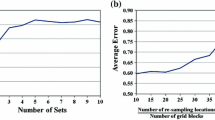Abstract
The performance of the ensemble Kalman filter (EnKF) for continuous updating of facies location and boundaries in a reservoir model based on production and facies data for a 3D synthetic problem is presented. The occurrence of the different facies types is treated as a random process and the initial distribution was obtained by truncating a bi-Gaussian random field. Because facies data are highly non-Gaussian, re-parameterization was necessary in order to use the EnKF algorithm for data assimilation; two Gaussian random fields are updated in lieu of the static facies parameters. The problem of history matching applied to facies is difficult due to (1) constraints to facies observations at wells are occasionally violated when productions data are assimilated; (2) excessive reduction of variance seems to be a bigger problem with facies than with Gaussian random permeability and porosity fields; and (3) the relationship between facies variables and data is so highly non-linear that the final facies field does not always honor early production data well. Consequently three issues are investigated in this work. Is it possible to iteratively enforce facies constraints when updates due to production data have caused them to be violated? Can localization of adjustments be used for facies to prevent collapse of the variance during the data-assimilation period? Is a forecast from the final state better than a forecast from time zero using the final parameter fields?
To investigate these issues, a 3D reservoir simulation model is coupled with the EnKF technique for data assimilation. One approach to enforcing the facies constraint is continuous iteration on all available data, which may lead to inconsistent model states, incorrect weighting of the production data and incorrect adjustment of the state vector. A sequential EnKF where the dynamic and static data are assimilated sequentially is presented and this approach seems to have solved the highlighted problems above. When the ensemble size is small compared to the number of independent data, the localized adjustment of the state vector is a very important technique that may be used to mitigate loss of rank in the ensemble. Implementing a distance-based localization of the facies adjustment appears to mitigate the problem of variance deficiency in the ensembles by ensuring that sufficient variability in the ensemble is maintained throughout the data assimilation period. Finally, when data are assimilated without localization, the prediction results appear to be independent of the starting point. When localization is applied, it is better to predict from the start using the final parameter field rather than continue from the final state.
Similar content being viewed by others
References
Anderson JL, Anderson SL (1999) A Monte Carlo implementation of the nonlinear filtering problem to produce ensemble assimilations and forecasts. Mon Weather Rev 127(12):2741–2758
Evensen G (2007) Data assimilation. The ensemble Kalman filter. Springer, New York
Galli A, Beucher H, Le Loc’h G, Doligez B, Heresim Group (1994) The pros and cons of the truncated Gaussian method. In: Geostatistical simulations. Kluwer Academic, Dordrecht, pp 217–233
Gaspari G, Cohn SE (1999) Construction of correlation functions in two and three dimensions. Q J R Meteor Soc 125:723–757
Hamill TM, Whitaker JS, Snyder C (2001) Distance-dependent filtering of background error covariance estimates in an ensemble Kalman filter. Mon Weather Rev 129(11):2776–2790
Houtekamer PL, Mitchell HL (1998) Data assimilation using an ensemble Kalman filter technique. Mon Weather Rev 126(3):796–811
Houtekamer PL, Mitchell HL (2001) A sequential ensemble Kalman filter for atmospheric data assimilation. Mon Weather Rev 129(1):123–137
Le Loc’h G, Galli A (1997) Truncated plurigaussian method: theoretical and practical points of view. In: Baafi EY, Schofield NA (eds) Geostatistics wollongong ’96, vol 1. Kluwer Academic, Dordrecht, pp 211–222
Le Loc’h G, Beucher H, Galli A, Doligez B, Heresim Group (1994) Improvement in the truncated Gaussian method: combining several Gaussian functions. In: Proceedings of ECMOR IV: fourth European conference on the mathematics of oil recovery
Liu N (2005) Automatic history matching of geologic facies. PhD thesis, University of Oklahoma
Liu N, Oliver DS (2004) Automatic history matching of geologic facies. Soc Petrol Eng J 9(4):429–436
Liu N, Oliver DS (2005) Critical evaluation of the ensemble Kalman filter on history matching of geologic facies. SPE Reserv Eval Eng 8(6):470–477
Mitchell HL, Houtekamer PL, Pellerin G (2002) Ensemble size, balance, and model-error representation in an ensemble Kalman filter. Mon Weather Rev 130(11):2791–2808
Oliver DS (1995) Moving averages for Gaussian simulation in two and three dimensions. Math Geol 27(8):939–960
Wen H-H, Tran TT, Behrens RA, Gómez-Hernández JJ (2002) Production data integration in sand/shale reservoirs using sequential self-calibration and geomorphing: a comparison. SPE Reserv Eval Eng 5(3):255–265
Xu C, Dowd PA, Mardiac KV, Fowella RJ (2006) A flexible true plurigaussian code for spatial facies simulations. Comput Geosci 32:1629–1645
Author information
Authors and Affiliations
Corresponding author
Rights and permissions
About this article
Cite this article
Agbalaka, C.C., Oliver, D.S. Application of the EnKF and Localization to Automatic History Matching of Facies Distribution and Production Data. Math Geosci 40, 353–374 (2008). https://doi.org/10.1007/s11004-008-9155-7
Received:
Accepted:
Published:
Issue Date:
DOI: https://doi.org/10.1007/s11004-008-9155-7



